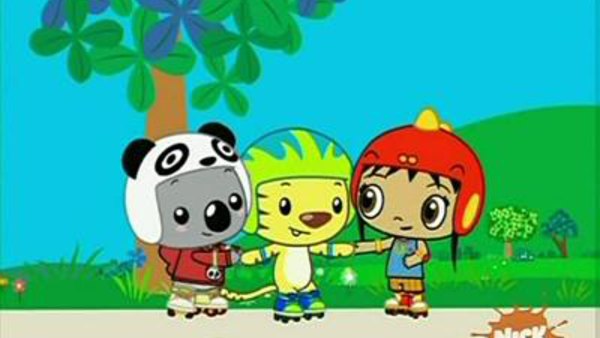As a parent, I always strive to find fun and educational activities for my little ones. One day, while flipping through channels, I stumbled upon “Ni Hao, Kai-Lan.” This vibrant children’s show, with its catchy tunes and adorable characters, immediately captured my child’s attention. What truly surprised me was the show’s ability to teach valuable life lessons through engaging storylines, and one episode in particular stuck with me. It featured the “Ant Playground,” a whimsical world brimming with imaginative play and collaborative adventures.

Image: simkl.com
This episode sparked a desire to understand the deeper meaning behind the “Ant Playground” and its significance in the show’s overall message. What exactly was the ant playground, and how did it teach children about friendship, teamwork, and self-discovery? This journey of discovery led me to delve into the educational value of “Ni Hao, Kai-Lan,” a show that seamlessly blends entertainment with meaningful learning experiences.
The Ant Playground: A Realm of Imagination
In the “Ant Playground” episode, Kai-Lan and her friends find themselves in a miniature world inhabited by ants. They learn that ants, despite their small size, work together to build their colony and achieve incredible feats. They see firsthand how ants share tasks, communicate with each other, and rely on each other’s strengths to complete their goals. The ants’ collaborative spirit becomes a powerful lesson for the children, showcasing the importance of teamwork and shared responsibilities.
The “Ant Playground” is more than just a physical place – it’s a metaphor for creativity and imagination. Children are encouraged to view the world through the eyes of ants, embracing their perspective and discovering the endless possibilities for play and exploration within their own surroundings. The episode emphasizes that even the smallest of things can have a big impact, and that working together can lead to extraordinary results.
Beyond the Playground: The Educational Value of “Ni Hao, Kai-Lan”
“Ni Hao, Kai-Lan,” with its simple yet powerful lessons, offers a valuable teaching tool for children of all ages. The show emphasizes the importance of respect, kindness, and inclusivity, encouraging children to appreciate diverse perspectives and cultures. By introducing Mandarin language and Chinese culture in a fun and engaging way, the show fosters empathy and cultural awareness, encouraging children to embrace the beauty of differences.
The “Ant Playground” episode is a perfect example of how “Ni Hao, Kai-Lan” uses imaginative storytelling to teach valuable life lessons. The episode not only reinforces the importance of teamwork but also highlights the significance of perseverance, problem-solving, and appreciating the little things in life. The show’s blend of humor, animation, and educational content captivates young viewers while promoting positive values and personal development.
“Ni Hao, Kai-Lan” effectively uses catchy songs and music to bolster learning, making it even more memorable for children. The show embraces a multi-modal approach to teaching, combining visuals, auditory elements, and interactive storytelling to create a dynamic learning experience. It’s a show that encourages children to participate, sing along, and engage with the characters and stories, making learning fun and engaging.
The show utilizes multicultural characters and storylines to promote diversity and inclusivity. The characters represent a variety of backgrounds and cultures, fostering a sense of belonging and acceptance for children from all walks of life. “Ni Hao, Kai-Lan” teaches children that collaboration, respect, and kindness are universal values that transcend cultural barriers.
Tips for Engaging Your Child with “Ni Hao, Kai-Lan”
As a parent, I’ve discovered several ways to make the “Ni Hao, Kai-Lan” experience even more enriching for my child. First, I encourage them to sing along with the show’s catchy tunes. This not only helps them learn new words and phrases, but also strengthens their memory and language skills. Second, I incorporate the lessons learned into everyday activities. For example, after watching the “Ant Playground” episode, we can discuss the importance of teamwork while playing games or completing chores together.
I also encourage my child to use their imagination and create their own versions of the ant playground. This can be as simple as building a miniature world out of blocks or drawing a picture of their own ant colony. By encouraging imaginative play, we can further reinforce the show’s message of creativity and self-expression.

Image: simkl.com
Frequently Asked Questions
Q: What are some of the most popular episodes of “Ni Hao, Kai-Lan”?
Some popular episodes include “The Ant Playground,” “The Lost Temple,” “The Dragon Boat Race,” “The Chinese New Year,” and “The Lantern Festival.”
Q: What age group is “Ni Hao, Kai-Lan” suitable for?
“Ni Hao, Kai-Lan” is suitable for children ages 2-7, but can also be enjoyed by older children and adults who appreciate its cultural richness and educational value.
Q: Where can I find “Ni Hao, Kai-Lan” episodes?
You can find “Ni Hao, Kai-Lan” on streaming platforms like Netflix, Amazon Prime Video, and YouTube. The show is also available on DVD.
Ni Hao Kai Lan The Ant Playground
In Conclusion
The “Ant Playground” episode of “Ni Hao, Kai-Lan” is a testament to the show’s ability to seamlessly blend entertainment with educational value. The episode teaches children valuable lessons about teamwork, perseverance, and embracing different perspectives. This show encourages creativity, promotes multicultural understanding, and strengthens language and social skills, making it a valuable resource for parents and educators alike.
Are you interested in incorporating “Ni Hao, Kai-Lan” into your child’s learning journey?





